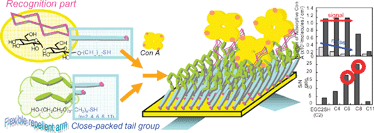Recognition of lectin with a high signal to noise ratio: carbohydrate-tri(ethylene glycol)-alkanethiol co-adsorbed monolayer†
Abstract
Densely packed co-adsorbed ultrathin mono molecular layers of short tri(ethylene glycol)-alkanethiolate (for repelling


 Please wait while we load your content...
Please wait while we load your content...